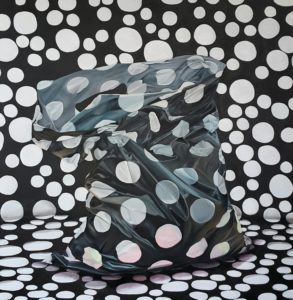2016
Oil on canvas
92 cm x 92 cm
“Ellipsis” by Katia Miranda is a photorealistic oil painting. It shows a black plastic shopping bag with white dots, in front of a background of a similar design. The bag stands upright and is open at the top. At first glance, one might think of a photography. Only a close-up examination reveals the real technique of the image. Due to the size of the painting and in absence of any reference to known objects in the picture, the original dimensions are uncertain. However, the bags wrinkling is strongly realistic. Even a content of red, white and dark objects, perhaps textile, seems to shimmer through the white dots. By the environment, the artist creates a comprehensible space by shadows. It looks like the bag is standing in front of a photo backdrop, as professional photographers use it.
That should not be accidental. The chosen polka dot plastic bag originates from a clothing store. Regarding the current tendencies in fashion, one could find blouses and shirts of the same design. Stagings like this are well known from the world of advertisement, when a model poses in a neutral environment to underline the garments to promote. Whereas, here the background highlights the object less. On the contrary, it reminds more to a camouflage.
Plastic shopping bags are often disguising their real nature by an appealing design. That makes the consumer wanting it, even if there is no need for it. In fortunate cases, the beautiful plastic bag is reused several times, but – since it is not intended to a long time usage – it eventually ends in the garbage, or worse in the nature.
Here we are approaching Katia’s motives. Even though she stages the by-product in a pleasing context, she wants to drive the attention to our careless handling of resources and the resulting environmental pollution. The worldwide wastage of shopping bags and other plastic products has led to a contamination of the oceans. Thereby the material jeopardises the flora and fauna and returns to us by the food chain. To hint on the destructive power of the object and its negative character, the artist might have chosen in this case a black grounded bag. In consequence, the cheerful white dots are nothing else than part of the camouflage.
Katia Miranda
Born in 1961 in El Salvador, Katia’s passion since her childhood was the dance. In consequence, she turned it into her profession and danced for 25 years with several companies in her home country, in the United States and in Guatemala. Furthermore, she studied Arts Management at the University of Tampa, Florida, received in 1984 her Bachelor of Science degree with the specialisation in visual arts and managed art galleries in Florida and El Salvador. After her marriage, she raised her children and worked in the family business.
Some years ago, Katia restarted to focus on visual arts and found here a new way to express herself. Mainly she paints inspired by her preparative photos, but she also creates self-reliant photos, sculptures and installations. Her working process is very thoroughly, since she makes numerous preliminary studies, before starting the actual execution. This might be a habit, which she learned in her longstanding carrier as dancer, where perseverance and hard labour were essential. The resulting oeuvres express that rigour, in particular the oil paintings, which are hyper-realistic with attention to details, like in our artwork of the month November 2017, where the onlooker might perceive the content of a plastic bag.
Katia is particularly attracted by plastic bags: their origin, their short time usage and their future existence as element of pollution. This approach is a result of an intensive reflexion about humans’ attitude to wrap almost everything. Not only are we wrapping objects (aliments, merchandises) and ourselves (garments) for protection, but often enough as well to conceal. An expensive outfit might be a camouflage; an unapproachable behaviour could mask true feelings; a shopping bag hides purchased goods. In addition, the wrapping can be an expression of brand loyalty and class affiliation.
Instead of denouncing the negative aspects of wrapping and especially the impact of plastic on our environment, Katia displays her beloved plastic bags like a luxury product and draws our attention to them. It is the artists’ invitation to us, to reflect about our handling with pollutant materials.
It is certainly no coincidence that the Colombian fashion designer Francesca Miranda was in 2016 so inspired by Katia’s paintings, that she created a series of dresses and purses after her paintings. Also, she took part in the group exhibition “Imago Mundi/Guatemala” by the collection of the Italian fashion entrepreneur Luciano Benetton. Beyond that, since 2009 the artist participates regularly in collective shows in Guatemala, El Salvador and Honduras. In 2016, she had her first solo exhibition in Colombia and in 2017 her works travelled for the first time to the United States (Naples, Florida) and Europe (Vienna, Austria and Florence, Italy).

